Grenades fly in Bengui
Captain Luis Coletes
Staff Sergeant Alberto Crespo
Special Operations Command
In Bangui, at that time, skirmishes and gunfire between the warring factions had become commonplace. The sound and the fury ring through the maze of streets every night. Members of the Special Operations Group have already spent months in the capital of the Central African Republic. They are stationed in the compound of an abandoned police station which has been ceeded by the local authorities. This is their base. Here, waking up to the sound of gunfire and exploding hand grenades is common. Smell and sound replace space and time between the station’s walls. The hatred between the Seleka and Antibalaka never stops. Nor do the Special Operations Command fighters, who from the first night take turns as night watchmen witohut distinguishing between rank or specialism. Everyone must work together for security. Everyone knows their mission is taking place in a dangerous place. We are in the Central African Republic and this is Bengui.
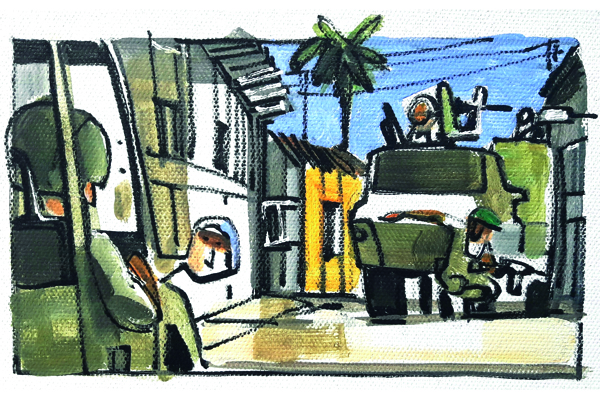
In Bangui, at that time, skirmishes and gunfire between the warring factions had become commonplace. The sound and the fury ring through the maze of streets every night. Members of the Special Operations Group have already spent months in the capital of the Central African Republic. They are stationed in the compound of an abandoned police station which has been ceeded by the local authorities. This is their base. Here, waking up to the sound of gunfire and exploding hand grenades is common. Smell and sound replace space and time between the station’s walls. The hatred between the Seleka and Antibalaka never stops. Nor do the Special Operations Command fighters, who from the first night take turns as night watchmen witohut distinguishing between rank or specialism. Everyone must work together for security. Everyone knows their mission is taking place in a dangerous place. We are in the Central African Republic and this is Bengui.
It is the 15th of October 2014 and a new mission begins when vehicles from the Spanish army leave the European base to carry out a routine patrol through the city. But the Special Operations Command fighters know that in Bangui there is no such thing as routine, that no two days are the same, that no route is the same and that there are no guarantees during a mission.
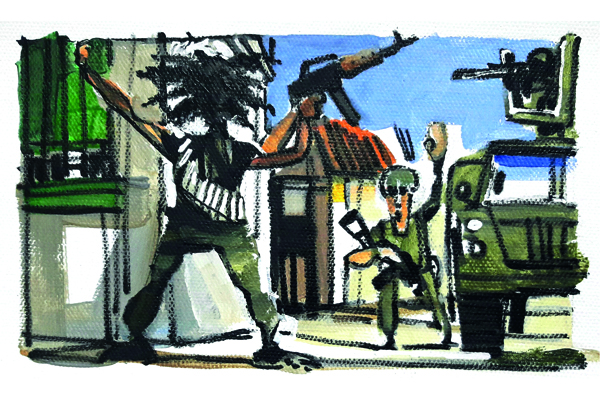
After more than four months working to support the civilian population, the people of the Central African Republic are used to having the Spaniards around, which is generally positive. The warring factions, however, whose weapons have been seized and whose hostile actions against their enemies have been hindered by the Spaniards, start to consider the Spaniards an obstacle, or even a threat.
It is a hot and clear day, like pretty much any other in Bangui at the time. During the return, and now less than a kilometre from the base, a French Infantry unit is deployed at an intersection in a defensive position, taking cover behind their vehicles covered in wheels and pointing their weapons north. Eight men from the Special Operations Command are travelling in two Lince vehicles. On board are two drivers, two shooters and only four men who are able to leave the vehicle. The Spanish armoured vehicles come to a stop and Captain Coletes gets out to ask the commander of the French unit, a lieutenant, about the situation. The lieutenant replies that an armed Antibalaka group seems to be approaching. The captain informs his commanding officers and suggests they stay with the French troops, to support them if the situation gets worse. The captain is authorised to stay and positions his vehicles on the west side of the intersection, protecting this front.
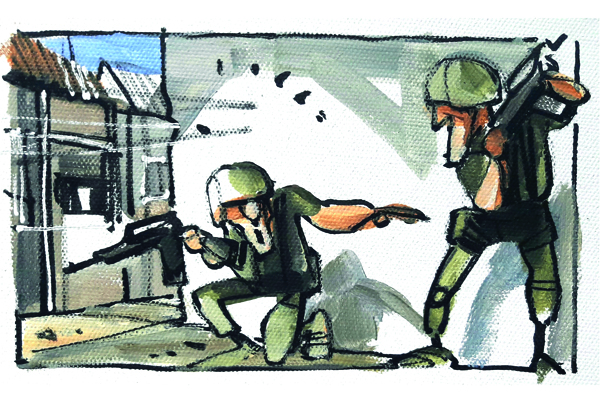
In a few minutes armoured personnel begin to arrive to the area. Normally, confronted by the EUFOR troops, these people wouldn’t set foot on the main roads, where they know that the EUFOR vehicles are dominant and have machine guns. Instead, they wait in the narrow alleyways which run at right angles to the main road, down which it is impossible for vehicles to travel. Anyone who goes down them on foot will quickly find themselves in the middle of a maze of houses without any signs in which it is very easy to become disorientated.
A commander from the Antibalaka group, who has been identified from previous occasions, abandons the safety of the alleyway and goes out on to the main road, positioning himself scarcely 20 metres from the vehicles. The enemy commander’s appearance is sinister, with long, curly hair, a skull hanging from his neck, a necklace with small leather bags, an AK-47 with three connected chargers, tactical belt, an axe and two knives, one on each ankle. In French, Captain Luis Coletes orders him to stop and put his weapon on the ground. Staff Sergeant Alberto Crespo also signals for him to do the same, but the man responds negatively and with an openly hostile attitude, his body language aggressive although he barely says a word, trying to intimidate them. The captain listens to one of his men on the radio, who is monitoring the behaviour of the man from the Antibalaka group: “Careful, he’s getting angry, his finger is on the trigger, he’s going to shoot.”
A hand grenade explodes
in the air just a few metres
from the captain and
hits him hard
More and more enemies arrive, raising the tension and, without any prior warning, a RPG-7 grenade crosses the north-south direction of the road, hitting a house close to the French troops’ position with a loud noise and forcing everyone to the ground. Instinctively, the captain looks towards the noise at the same time as the enemy commander raises his rifle to fire at them, but the shooter from the first Lince vehicle, Riaza, quickly fires at the enemy commander with his machine gun, taking him down instantly.
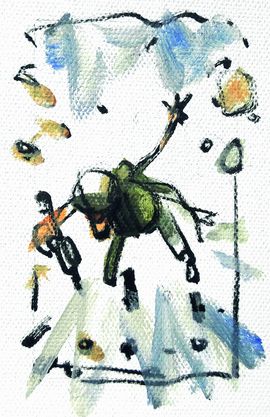
Just then, they start taking fire from the alleyways. Everyone gets out, returning the fire. A number of grenades fly, and one slips under a vehicle but doesn’t hurt any of the soldiers, who are already out. Staff Sergeant Crespo quickly moves towards the enemy commander’s body to disarm him and to ensure his assault rifle doesn’t fall into other hands. Then they receive fire from rifles and grenades, which is strongly responded to by the two machine gun shooters from the vehicles, Guzmán and Riaza, who manage to silence the enemy fire. Alberto seizes this opportunity to hang up the AK-47 and jump onto his vehicle to board it again.
From the vehicles they can make out lots of armed personnel quickly crossing from one side of the road to another and firing as they go. The Spaniards return the fire. One armed individual fires at the captain, hitting the wall which he is leaning against a number of times. Luis responds by firing down the alley, even supporting the rifle on his opposite shoulder, such is the risk of leaning into the alleyway. The captain and the staff sergeant continue to advance with the idea of not staying in the defensive position and not losing contact with the enemy. One of them shoots towards him, hitting the ground, then runs away and shelters behind a house. The captain fires ten or twelve cartridges against the wall of the same house, so that the enemy can see that they know where he is and that they are firing even though he isn’t in firing range.
At this point, he looks behind and sees that he and Staff Sergeant Crespo have gone 30 metres forward down the roads, and now they can’t see the Lince from their position, so they start to bound back to the main road, protected by the fire.
They quickly arrive at the start of the alleyway, where the vehicles are still covering sectors. Staff Sergeant Crespo gets to his Lince and, just when the captain turns to take the last leap, an enemy hand grenade explodes in the air a few metres above his head, hitting him hard. He feels an enormous pressure in his head, burns on his arms and neck, as if he had been splashed with acid, and a great pain in his right arm. He can hardly hear, although he is wearing earplugs designed especially for gunshots (the French troops recommended that they wear them, because many of their men had sufferred ear injuries), and he finds himself enveloped in a cloud of dust which completely surrounds him. At this point he realises he is injured. With his injuries he leaps towards the vehicles again, leaning his back against the Lince’s door and shooting six or eight times in the opposite direction.
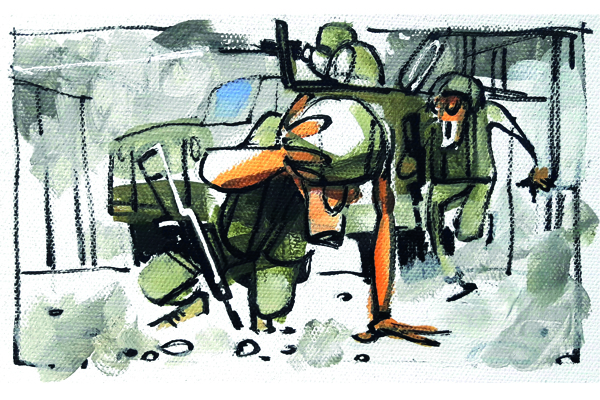
Seconds pass, and, beacuse he doesn’t hear any more shots, he enters the vehicle, feeling his hearing return. He takes the radio and reports the situation, explaining that they came under heavy fire. At the end he adds: “you should know that I’m injured”. The reply is: “Repeat the last message, did you say injured?”. He replies yes, and they ask him: “Minor or serious?”, to which he responds: “I think it’s minor”. The corporal driver Abel tells him to look at his arm. A piece of shrapnel is embedded in it.

The protocol to take him to the base is quickly put into action. Immediately, he is taken to the ROLE 1 hospital, where French medical personnel are waiting for him, and from there he is quickly transferred in a convoy to ROLE 2, where he is operated upon.
Three days later he is brought back to Spain and in his mind there is only one thought: getting back to the mission, getting back to Bangui. After another operation and two weeks recuperating, Captain Coletes receives authorisation to reutrn to the Central African Republic to finish his mission. Waiting for him there are the men who, on the 15th of October 2014, fought with strength, confidence and bravery in the streets of Bangui: Abel, Checa, Calderón, Guzmán, Riaza, Andrés, Diego and Alberto.
ARMY UNITS
- Araba Álava |
- Albacete |
- Alicante |
- Almería |
- Asturias |
- Ávila |
- Badajoz |
- Barcelona |
- Burgos |
- Cáceres |
- Cádiz |
- Cantabria |
- Castellón |
- Ceuta |
- Ciudad Real |
- Córdoba |
- A Coruña |
- Cuenca |
- Girona |
- Granada |
- Guadalajara |
- Gipuzkoa |
- Huelva |
- Huesca |
- Islas Baleares |
- Jaén |
- León |
- Lleida |
- Lugo |
- Madrid |
- Málaga |
- Melilla |
- Murcia |
- Navarra |
- Ourense |
- Palencia |
- Las Palmas |
- Pontevedra |
- La Rioja |
- Salamanca |
- Segovia |
- Sevilla |
- Soria |
- Tarragona |
- Santa Cruz de Tenerife |
- Teruel |
- Toledo |
- Valencia |
- Valladolid |
- Bizkaia |
- Zamora |
- Zaragoza



